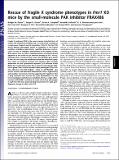| dc.contributor.author | Govindarajan, Arvind | |
| dc.contributor.author | Tonegawa, Susumu | |
| dc.contributor.author | Dolan, Bridget M. | |
| dc.contributor.author | Lin, Gregory G. | |
| dc.contributor.author | Duron, Sergio G. | |
| dc.contributor.author | Campbell, David A. | |
| dc.contributor.author | Vollrath, Benedikt | |
| dc.contributor.author | Rao, B. S. Shankaranarayana | |
| dc.contributor.author | Ko, Hui-Yeon | |
| dc.contributor.author | Choi, Se-Young | |
| dc.date.accessioned | 2013-10-03T16:21:54Z | |
| dc.date.available | 2013-10-03T16:21:54Z | |
| dc.date.issued | 2013-03 | |
| dc.date.submitted | 2012-11 | |
| dc.identifier.issn | 0027-8424 | |
| dc.identifier.issn | 1091-6490 | |
| dc.identifier.uri | http://hdl.handle.net/1721.1/81290 | |
| dc.description.abstract | Fragile X syndrome (FXS) is the most common inherited form of autism and intellectual disability and is caused by the silencing of a single gene, fragile X mental retardation 1 (Fmr1). The Fmr1 KO mouse displays phenotypes similar to symptoms in the human condition—including hyperactivity, repetitive behaviors, and seizures—as well as analogous abnormalities in the density of dendritic spines. Here we take a hypothesis-driven, mechanism-based approach to the search for an effective therapy for FXS. We hypothesize that a treatment that rescues the dendritic spine defect in Fmr1 KO mice may also ameliorate autism-like behavioral symptoms. Thus, we targeted a protein that regulates spines through modulation of actin cytoskeleton dynamics: p21-activated kinase (PAK). Our results demonstrate that a potent small molecule inhibitor of group I PAKs reverses dendritic spine phenotypes in Fmr1 KO mice. Moreover, this PAK inhibitor—which we call FRAX486—also rescues seizures and behavioral abnormalities such as hyperactivity and repetitive movements, thereby supporting the hypothesis that a drug treatment that reverses the spine abnormalities can also treat neurological and behavioral symptoms. Finally, a single administration of FRAX486 is sufficient to rescue all of these phenotypes in adult Fmr1 KO mice, demonstrating the potential for rapid, postdiagnostic therapy in adults with FXS. | en_US |
| dc.description.sponsorship | National Institutes of Health (U.S.) (Grant R01-MH078821) | en_US |
| dc.description.sponsorship | National Institutes of Health (U.S.) (Grant P50-MH58880) | en_US |
| dc.description.sponsorship | RIKEN Brain Science Institute | en_US |
| dc.description.sponsorship | Massachusetts Institute of Technology. Simons Center for the Social Brain | en_US |
| dc.language.iso | en_US | |
| dc.publisher | National Academy of Sciences (U.S.) | en_US |
| dc.relation.isversionof | http://dx.doi.org/10.1073/pnas.1219383110 | en_US |
| dc.rights | Article is made available in accordance with the publisher's policy and may be subject to US copyright law. Please refer to the publisher's site for terms of use. | en_US |
| dc.source | PNAS | en_US |
| dc.title | Rescue of fragile X syndrome phenotypes in Fmr1 KO mice by the small-molecule PAK inhibitor FRAX486 | en_US |
| dc.type | Article | en_US |
| dc.identifier.citation | Dolan, B. M., S. G. Duron, D. A. Campbell, B. Vollrath, B. S. S. Rao, H.-Y. Ko, G. G. Lin, A. Govindarajan, S.-Y. Choi, and S. Tonegawa. “Rescue of fragile X syndrome phenotypes in Fmr1 KO mice by the small-molecule PAK inhibitor FRAX486.” Proceedings of the National Academy of Sciences 110, no. 14 (April 2, 2013): 5671-5676. | en_US |
| dc.contributor.department | Massachusetts Institute of Technology. Department of Biology | en_US |
| dc.contributor.department | Massachusetts Institute of Technology. Department of Brain and Cognitive Sciences | en_US |
| dc.contributor.department | Picower Institute for Learning and Memory | en_US |
| dc.contributor.department | RIKEN-MIT Center for Neural Circuit Genetics | en_US |
| dc.contributor.mitauthor | Govindarajan, Arvind | en_US |
| dc.contributor.mitauthor | Tonegawa, Susumu | en_US |
| dc.contributor.mitauthor | Dolan, Bridget M. | en_US |
| dc.contributor.mitauthor | Lin, Gregory G. | en_US |
| dc.relation.journal | Proceedings of the National Academy of Sciences | en_US |
| dc.eprint.version | Final published version | en_US |
| dc.type.uri | http://purl.org/eprint/type/JournalArticle | en_US |
| eprint.status | http://purl.org/eprint/status/PeerReviewed | en_US |
| dspace.orderedauthors | Dolan, B. M.; Duron, S. G.; Campbell, D. A.; Vollrath, B.; Rao, B. S. S.; Ko, H.-Y.; Lin, G. G.; Govindarajan, A.; Choi, S.-Y.; Tonegawa, S. | en_US |
| dc.identifier.orcid | https://orcid.org/0000-0003-2839-8228 | |
| dc.identifier.orcid | https://orcid.org/0000-0003-3984-6057 | |
| mit.license | PUBLISHER_POLICY | en_US |
| mit.metadata.status | Complete | |
